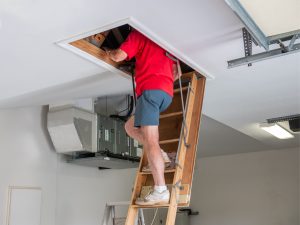5 Ways to Make Your Attic More Energy Efficient
Posted on March 14th, 2022 by carrolladmin

Did you know that 9 out of 10 homes are poorly insulated? Furthermore, inefficient attic insulation can cause your summer and winter energy bills to climb by as much as 15%?
You might be saying to yourself, “that doesn’t apply to me because the last time I looked inside my attic, I saw insulation.”
But what type of insulation do you have up there?
Homes that are ten years or older often have insulation that’s too thin to provide any real benefits. There could also be many other issues that are causing your cooling and heating bills to skyrocket in the summer and winter months.
Read on to learn more about five ways to prevent heat and cooling loss through your attic and decrease your energy bill.
- Add New Attic Insulation
- Insulate Your Attic Ductwork
- Ensure Attic Vents Are Working
- Seal Air Leaks
- Seal the Attic Entryway
1. Add New Attic Insulation
According to EnergyStar.gov, the EPA estimates that the average homeowner can save up to 15% in heating and cooling costs by adding proper insulation. If your home was built before the 1970s, there’s an excellent chance that it has inadequate insulation.
There are two main ways to perform a self-check to see if you need to replace your attic insulation. The first method is to look to see if the insulation is flush with or lower than your floor joists. If so, it’s time to call out the professionals to install new insulation.
The second method involves looking at the “R rating” of your current insulation, measuring the depth of it with a tape measure, and then performing calculations based on a table created by EnergyStar.gov.
It’s important to keep in mind that even if your current insulation passes the self-check—that doesn’t necessarily mean that all is well. The “R rating” of your insulation tells you how effective it is. Most homes that are 10 years older have R-11 or R-15 insulation—which pales in their ability to insulate compared to modern-day R-30 insulation.
2. Insulate Your Attic Ductwork
If your HVAC ductwork passes through your attic, there’s a good chance that it can suffer from cool or hot air loss as some of it gets leached out before it reaches your living space. The only way to solve this problem is to have the professionals install a special type of insulation that completely covers the duct and prevents heat or cool air transfer.
3. Ensure Attic Vents Are Working
The vents inside your attic could become clogged with dirt, animal debris, or rusted shut in cases of passively moving fans. This can lead to mildew and moisture forming, which causes wood rot and deterioration of your insulation over time. Also, your vents could hinder the amount of incoming fresh air if they are improperly configured for your attic space.
While vents do cause heat loss—this should not be a concern for a properly insulated attic. As the old saying goes, “what happens in the attic, should stay in the attic.” Vents help ensure that the stale, moisture-laden air has a way of escaping your attic before it turns into condensation. As long as you have adequate insulation, there’s no need to worry about your vents allowing heated or cooled air to escape your home.
4. Seal Air Leaks
Air leaks between your attic and living space can cause a tremendous amount of energy loss—and put unnecessary wear and tear on your HVAC equipment as it’s forced to work harder to keep your home cooler or warmer. If you start to notice your heater or A/C turning on more frequently, there’s a chance that you might have an air leak somewhere in your home.
The best way to test for a leak is to grab an LED flashlight and have someone go up inside your attic. Shine the light over any potential gaps. If the person inside your attic sees the light, you have a leak. To test window sills and door frames, shine the light up and down the seals and have someone on the other side look for gaps of light.
5. Seal the Attic Entryway
The entryway into the attic is often overlooked by homeowners. Depending on the configuration of your home, it could be a small crawl space or an opening in the ceiling with pull-down stairs. More often than not, this area is not insulated properly and can result in major air leakage.
While weather stripping and other DIY projects can provide a quick fix, the best way to ensure a tight air seal on your attic entryway is to buy and install a specialized attic door cover. It will help seal any gaps and prevent air from escaping your home and into your attic.
Let Carroll Plumbing & Heating Help Decrease Your Energy Bill
Inefficient attics can negatively affect the lifespan of your HVAC equipment by causing it to work harder and turn on more frequently. If you’re experiencing high energy bills or would like to learn more about how to make your attic more efficient, get in touch with the experts at Carroll Plumbing & Heating.
Click below to explore our comprehensive HVAC services.






